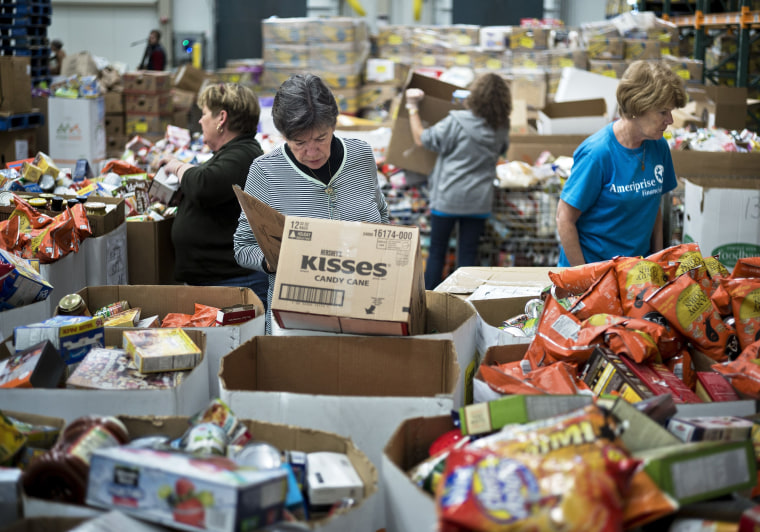
By Elisha Fieldstadt, NBC News
Food pantries and food banks struggled to meet demand this Thanksgiving, just weeks after food stamp cuts for millions of Americans took effect.
On Nov. 1, the 47 million people who rely on food stamps — also known as the Supplemental Nutrition Assistance Program (SNAP) — saw a decrease in benefits when Congress allowed a 2009 program funding boost to expire. As a result, a family of four will receive $36 less in food stamps in November and each month thereafter, according to the USDA.
“All of our food banks have really ratcheted up what they have had to serve,” said Ross Fraser, media relations director at Feeding America, a network of 200 food banks that serve 61,000 food pantries across the nation. In 2010, Feeding America determined that 37 million Americans turn to food pantries each year.
Across the nation, food pantry workers say they have seen a rush of clients, including many who have never turned to a pantry before but now “need help more often because they have fewer food stamps,” Fraser said.
Marianne Smith Vargas, chief philanthropy officer at Foodbank of Southeastern Virginia, said, “We are hearing story after story about how a family was just making ends meet on what they received in food stamps prior to the cut. Now, even the smallest cut is forcing them to come to the Foodbank for help.”
This month, Foodbank has seen a 40 percent jump in families seeking assistance compared with November 2012, and most of those families are first-time clients, Vargas said.
At NY Common Pantry in Manhattan, officials have seen a 25 percent increase in new families in 2013, “even before the SNAP cuts took effect,” said Kelly Barkley, a development associate.
So far, the pantry has been able to provide for the influx of new applicants, executive director Stephen Grimaldi said, but additional potential SNAP cuts looming in Congress “may change this in the near future.”
Barkley said that NY Common Food Pantry has also had to adjust to a lack of government funding this year. In 2012, the U.S. government purchased $560 million worth of food for charities, but in 2013 the funding was slashed to $495 million. Feeding America’s director of tax and commodity policy, Carrie Calvert, said food banks will have to find a way to compensate for the 25 percent decrease in federal food deliveries.
The reductions in government aid occurring in tandem with the November food stamp cuts have forced NY Common Food Pantry to “nimbly use resources,” Barkley said. “Perhaps there’s some days where we don’t offer poultry, but we will have another source of protein,” she said.
Pacitia Trim, 31, a single mother of seven who visits NY Common Pantry every two weeks, has detected the cutbacks. “I noticed that they used to do a lot more meats and things and sometimes eggs … I’ve not seen that now,” she said.
Trim said she relies on her food stamps to fill the gaps of what she’s not getting at the food pantry, but those run out within three weeks, which was common among SNAP recipients even before the cuts, according to Feeding America.
After the cuts, SNAP benefits allow an average of $1.40 per person per meal, according to the Center on Budget and Policy Priorities. Meanwhile the average cost of a meal in most states hovers around $2.50. In New York, the average price of a meal is $2.68.
Trim said she was grateful that NY Common Pantry would provide her with a turkey for Thanksgiving. Only those who are members of the food pantry can register for the holiday extra, she said, and since so many new people are visiting now, “there are still going to be a lot of people that aren’t going to be able to collect this year,” she said.
“It’s really stressful,” said Trim, whose children range in age from four months to 13 years.
At the Door of Hope food pantry in Los Angeles, director Lydia Cardenas sees countless clients facing Trim’s predicament. Prior to Nov. 1, she saw one high-traffic day a week, but “now we’re always busy,” she said.
“It’s impossible to keep up with the demand, because everybody is struggling,” said Cardenas, who recently registered for unemployment herself after realizing it was impossible to remain salaried at the pantry due to funding cuts.
“I’m a volunteer, effective October 31,” Cardenas said, but added, “When you help somebody else, it takes the focus off your own problems.”
The pantry was able to assemble 55 Thanksgiving baskets, but Cardenas wishes they could have made enough to avoid adding applicants to an ever-growing waiting list. “The hard part of doing this is that we hate saying no,” she said. “We just don’t have the ability to do much more.”
Related: